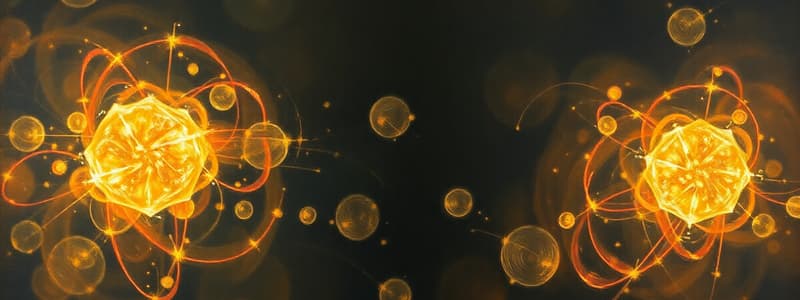Podcast
Questions and Answers
What happens to the kinetic energy of gas particles when the temperature of the gas increases?
What happens to the kinetic energy of gas particles when the temperature of the gas increases?
- It increases, causing particles to collide less frequently.
- It increases, causing particles to move faster. (correct)
- It stays the same, as temperature does not affect kinetic energy.
- It decreases, causing particles to move slower.
How does the pressure inside a closed container behave when the volume of the container is decreased?
How does the pressure inside a closed container behave when the volume of the container is decreased?
- The pressure fluctuates randomly and is unpredictable.
- The pressure decreases as the particles have less space.
- The pressure increases as particles collide more frequently with the walls. (correct)
- The pressure remains unchanged regardless of volume.
What is the primary factor that contributes to gas pressure within a closed container?
What is the primary factor that contributes to gas pressure within a closed container?
- The mass of the gas particles inside the container.
- The temperature of the gas relative to surrounding areas.
- The frequency of collisions of gas particles against the container walls. (correct)
- The shape of the container itself.
In the context of a bicycle pump, what effect does compressing the pump have on the volume and pressure of the air inside?
In the context of a bicycle pump, what effect does compressing the pump have on the volume and pressure of the air inside?
What can be inferred about the relationship between temperature and gas pressure in a flexible container?
What can be inferred about the relationship between temperature and gas pressure in a flexible container?
What characteristic distinguishing solids from liquids allows solids to maintain their shape?
What characteristic distinguishing solids from liquids allows solids to maintain their shape?
Which statement best describes the density of gases compared to solids and liquids?
Which statement best describes the density of gases compared to solids and liquids?
What is the primary reason that liquids can flow easily?
What is the primary reason that liquids can flow easily?
Which state of matter has the highest energy level of its particles?
Which state of matter has the highest energy level of its particles?
Why can gases be compressed into a much smaller volume compared to liquids and solids?
Why can gases be compressed into a much smaller volume compared to liquids and solids?
What distinguishes the arrangement of particles in solids from that in liquids and gases?
What distinguishes the arrangement of particles in solids from that in liquids and gases?
How does pressure in gases arise within a container?
How does pressure in gases arise within a container?
In what way does the density of water differ from typical solids and liquids?
In what way does the density of water differ from typical solids and liquids?
What is the purpose of a heating curve?
What is the purpose of a heating curve?
What occurs during the horizontal sections of a heating curve?
What occurs during the horizontal sections of a heating curve?
What is the primary energy transformation that occurs during the melting process?
What is the primary energy transformation that occurs during the melting process?
How does heating a gas affect its volume?
How does heating a gas affect its volume?
Which statement accurately describes freezing compared to melting?
Which statement accurately describes freezing compared to melting?
What is the effect of decreasing the volume of a gas in a container?
What is the effect of decreasing the volume of a gas in a container?
What distinguishes boiling from evaporation?
What distinguishes boiling from evaporation?
What is a cooling curve?
What is a cooling curve?
What does the graph of a cooling curve resemble?
What does the graph of a cooling curve resemble?
During the process of evaporation, which particles are most likely to escape from the liquid?
During the process of evaporation, which particles are most likely to escape from the liquid?
What happens when the air inside a hot air balloon is heated?
What happens when the air inside a hot air balloon is heated?
What must occur for a liquid to transition into a solid state?
What must occur for a liquid to transition into a solid state?
Which physical property is NOT influenced by the arrangement of particles in different states of matter?
Which physical property is NOT influenced by the arrangement of particles in different states of matter?
Density changes in gases with temperature increase are typically characterized by which statement?
Density changes in gases with temperature increase are typically characterized by which statement?
What is the process when a solid changes directly into a gas called?
What is the process when a solid changes directly into a gas called?
What happens to the energy of particles in a substance during the heating process?
What happens to the energy of particles in a substance during the heating process?
What two conditions primarily affect the rate of evaporation of a liquid?
What two conditions primarily affect the rate of evaporation of a liquid?
During condensation, what happens to the particles of the gas?
During condensation, what happens to the particles of the gas?
Which of the following statements accurately describes sublimation?
Which of the following statements accurately describes sublimation?
What is desublimation?
What is desublimation?
In the context of kinetic theory, what happens when a solid is heated?
In the context of kinetic theory, what happens when a solid is heated?
What role does thermal energy play in the state change of liquids?
What role does thermal energy play in the state change of liquids?
Which statement is true regarding the process of melting?
Which statement is true regarding the process of melting?
How does the particle theory explain the transition of states?
How does the particle theory explain the transition of states?
Flashcards are hidden until you start studying
Study Notes
Kinetic Theory
- Solids have a fixed shape and volume.
- Liquids maintain a fixed volume but adopt the shape of the container.
- Gases have neither a fixed shape nor volume, filling the entire container.
- Solids have a high density because particles are tightly packed and vibrate in fixed positions.
- Liquids are less dense than solids (except water), but denser than gases. Particles move and slide past each other, allowing liquids to flow.
- Gases have the lowest density due to the large spaces between randomly moving particles.
- Gases are highly compressible due to the loose arrangement of particles.
- In gases, particles collide with each other and the container walls, leading to pressure.
States of Matter
- Melting: A solid transforms into a liquid when heated. This occurs at the melting point (m.p.) and involves particles gaining kinetic energy, enabling them to move more freely.
- Boiling: A liquid transforms into a gas when heated. Bubbles of gas form within the liquid, allowing particles to escape from the surface and interior. The boiling point (b.p.) is the specific temperature at which this occurs.
- Freezing: A liquid transforms into a solid when cooled. It is the reverse of melting and happens at the same temperature.
- Evaporation: A liquid transforms into a gas over a range of temperatures below the boiling point. High-energy particles escape from the liquid's surface.
- Condensation: A gas transforms into a liquid when cooled. Gas particles lose energy, clump together, and form a liquid.
- Sublimation: A solid directly transforms into a gas, happening for select solids.
- Desublimation/Deposition: The reverse process of sublimation, where a gas directly transforms into a solid.
State Changes & Kinetic Theory
- Heating a substance increases kinetic energy as thermal energy is converted.
- Heating a solid causes particles to vibrate more. The solid expands until it melts.
- Further heating a liquid causes more expansion and surface particles gain enough energy to evaporate.
- Heating a liquid to its boiling point allows all particles to overcome forces and boil.
- Cooling down a gas reverses these processes.
Heating and Cooling Curves
- A heating curve shows temperature changes and state changes over time.
- The horizontal sections represent changes of state with no temperature change.
- A cooling curve is the reverse of the heating curve.
Pressure and Temperature in Gases
- Temperature and pressure changes affect gas volume.
- Increasing temperature increases gas volume. The expansion causes density to decrease.
- Decreasing volume increases the pressure of a gas. This is why a bicycle pump inflates tires.
- Gases exert pressure by particles colliding with container walls.
- Increasing temperature increases the kinetic energy of gas particles, leading to more collisions with the container walls.
- Decreasing the container volume increases the frequency of collisions, increasing the gas pressure.
Studying That Suits You
Use AI to generate personalized quizzes and flashcards to suit your learning preferences.




